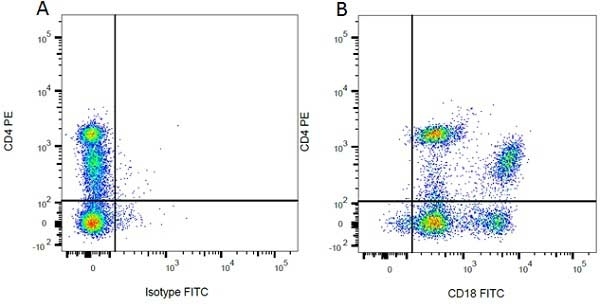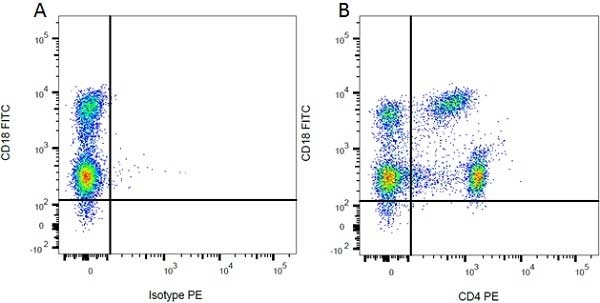CD18 antibody | WT.3


Mouse anti Rat CD18
- Product Type
- Monoclonal Antibody
- Clone
- WT.3
- Isotype
- IgG1
- Specificity
- CD18
| Mouse anti Rat CD18 antibody, clone WT.3 reacts with the rat beta 2 integrin, which is designated CD18. The beta 2 integrin may be associated with the integrin alphaL, alphaX or alphaM subunits. CD18 is expressed by all leucocytes. Mouse anti Rat CD18 antibody has been shown to inhibit homotypic aggregation of PHA blasts. It also blocks binding of rat lymphocytes to purified rat ICAM-1. |
- Target Species
- Rat
- Product Form
- Purified IgG - liquid
- Preparation
- Purified IgG prepared by affinity chromatography on Protein G from tissue culture supernatant
- Buffer Solution
- Phosphate buffered saline
- Preservative Stabilisers
0.09% Sodium Azide - Carrier Free
- Yes
- Immunogen
- FTL-43.
- Approx. Protein Concentrations
- IgG concentration 1 mg/ml
- Fusion Partners
- Lymph node cells from an immunized BALB/c mouse were fused with cells of the PAI mouse myeloma cell line.
- Regulatory
- For research purposes only
- Guarantee
- 12 months from date of despatch
Avoid repeated freezing and thawing as this may denature the antibody. Storage in frost-free freezers is not recommended.
| Application Name | Verified | Min Dilution | Max Dilution |
|---|---|---|---|
| Flow Cytometry | 1/10 | 1/50 | |
| Immunohistology - Frozen | |||
| Immunoprecipitation |
- Flow Cytometry
- Use 10ul of the suggested working dilution to label 106 cells in 100ul.
| Description | Product Code | Applications | Pack Size | List Price | Your Price | Quantity | |
|---|---|---|---|---|---|---|---|
| Mouse IgG1 Negative Control | MCA1209 | F | 0.1 mg |
|
Log in | ||
| List Price | Your Price | ||||||
|
|
Log in | ||||||
| Description | Mouse IgG1 Negative Control | ||||||
References for CD18 antibody
-
Tamatani, T. & Miyasaka, M. (1990) Identification of monoclonal antibodies reactive with the rat homolog of ICAM-1, and evidence for a differential involvement of ICAM-1 in the adherence of resting versus activated lymphocytes to high endothelial cells.
Int Immunol. 2 (2): 165-71. -
Tamatani, T. et al. (1991) Characterization of the rat leukocyte integrin, CD11/CD18, by the use of LFA-1 subunit-specific monoclonal antibodies.
Eur J Immunol. 21 (3): 627-33. -
Tamatani, T. et al. (1991) Molecular mechanisms underlying lymphocyte recirculation. II. Differential regulation of LFA-1 in the interaction between lymphocytes and high endothelial cells.
Eur J Immunol. 21 (3): 855-8. -
Alvarez, A. et al. (2007) Gastric antisecretory drugs induce leukocyte-endothelial cell interactions through gastrin release and activation of CCK-2 receptors.
J Pharmacol Exp Ther. 323. 406-413. -
Wu, J.C. et al. (1996) The relationship of adhesion molecules and leukocyte infiltration in chronic tubulointerstitial nephritis induced by puromycin aminonucleoside in Wistar rats.
Clin Immunol Immunopathol. 79 (3): 229-35. -
Nicholls, S.M. et al. (2006) Differences in leukocyte phenotype and interferon-gamma expression in stroma and endothelium during corneal graft rejection.
Exp Eye Res. 83 (2): 339-47. -
Ishida, S. et al. (2003) Leukocytes mediate retinal vascular remodeling during development and vaso-obliteration in disease.
Nat Med. 9 (6): 781-8. -
Fabian, R.H. & Kent, T.A. (1999) Superoxide anion production during reperfusion is reduced by an antineutrophil antibody after prolonged cerebral ischemia.
Free Radic Biol Med. 26 (3-4): 355-61.
View The Latest Product References
-
Shen K et al. (1995) Circulating leukocyte counts, activation, and degranulation in Dahl hypertensive rats.
Circ Res. 76 (2): 276-83. -
Nutile-McMenemy, N. et al. (2007) Minocycline decreases in vitro microglial motility, beta1-integrin, and Kv1.3 channel expression.
J Neurochem. 103 (5): 2035-46. -
Martinelli, R. et al. (2009) ICAM-1-mediated endothelial nitric oxide synthase activation via calcium and AMP-activated protein kinase is required for transendothelial lymphocyte migration.
Mol Biol Cell. 20 (3): 995-1005. -
Herrmann, I.K. et al. (2015) Differentiating sepsis from non-infectious systemic inflammation based on microvesicle-bacteria aggregation.
Nanoscale. 7 (32): 13511-20. -
Gu, Y. et al. (2019) Defining the structural basis for human alloantibody binding to human leukocyte antigen allele HLA-A*11:01.
Nat Commun. 10 (1): 893. -
Dragoni, S. et al. (2020) Endothelial Protease Activated Receptor 1 (PAR1) Signalling Is Required for Lymphocyte Transmigration across Brain Microvascular Endothelial Cells.
Cells. 9(12):2723.
- Synonyms
- Integrin Beta 2 Chain
- RRID
- AB_2128469
MCA775
If you cannot find the batch/lot you are looking for please contact our technical support team for assistance.
Please Note: All Products are "FOR RESEARCH PURPOSES ONLY"
View all Anti-Rat ProductsAlways be the first to know.
When we launch new products and resources to help you achieve more in the lab.
Yes, sign me up
